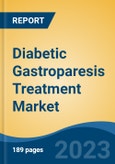Speak directly to the analyst to clarify any post sales queries you may have.
10% Free customizationThis report comes with 10% free customization, enabling you to add data that meets your specific business needs.
According to a 2025 study in Frontiers, gastrointestinal symptoms affect 5% to 12% of diabetic individuals, highlighting the need for improved diagnostic and treatment solutions. The market spans pharmaceuticals, dietary modifications, and medical devices, with key products including prokinetic agents, antiemetics, and nutritional support tools. These treatment modalities aim to alleviate symptoms like nausea, vomiting, abdominal pain, and indigestion, ultimately enhancing patients’ quality of life. The growing emphasis on patient-centric care and innovative therapies continues to reshape this evolving healthcare landscape.
Key Market Drivers
Rising Prevalence of Diabetes
A significant driver of the Global Diabetic Gastroparesis Treatment Market is the escalating prevalence of diabetes worldwide. Both type 1 and type 2 diabetes have reached alarming levels, with WHO data showing an increase in global diabetes cases from 200 million in 1990 to 830 million in 2022. Among these individuals, approximately 20% experience diabetic gastroparesis due to nerve damage affecting stomach motility. The link between chronic hyperglycemia and gastrointestinal complications means that as diabetes becomes more widespread, so does the incidence of gastroparesis. Notably, in 2022, 14% of adults aged 18+ had diabetes, and over half of diabetic adults aged 30+ remained untreated - particularly in low- and middle-income countries. This growing diabetic population continues to fuel demand for effective treatment options that address gastroparesis symptoms and prevent further complications, positioning this segment as a critical focus within global healthcare.Key Market Challenges
Limited Treatment Options
Despite progress in managing diabetic gastroparesis, the market still struggles with limited treatment options. The primary drugs used - prokinetic agents and antiemetics - offer only partial relief and are not effective for all patients. This narrow pharmaceutical toolkit leaves many individuals without adequate solutions for persistent symptoms like nausea, bloating, and abdominal pain.The lack of diverse and universally effective medications restricts clinicians' ability to personalize treatment and achieve consistent patient outcomes. Moreover, when standard therapies fail, patients often endure ongoing discomfort, leading to diminished quality of life. Healthcare providers also face difficulty managing a condition that lacks sufficient therapeutic diversity. Addressing this challenge requires greater investment in R&D to develop novel drugs, improve existing formulations, and introduce more targeted treatment approaches capable of catering to a wider range of patient responses.
Key Market Trends
Personalized Medicine
Personalized medicine is gaining momentum in the Global Diabetic Gastroparesis Treatment Market as a transformative trend focused on tailoring treatments to individual patient needs. Since diabetic gastroparesis presents differently across patients, personalization enables more precise and effective symptom management. By factoring in each patient’s medical history, symptom severity, and therapeutic response, healthcare providers can optimize treatment strategies - choosing between drug classes like prokinetic agents, antiemetics, or alternative therapies as appropriate. This customized approach improves efficacy, reduces side effects, and enhances patient satisfaction. The rise of personalized medicine underscores a shift toward targeted care, where data-driven decisions and individualized protocols support better health outcomes and address the variability inherent in diabetic gastroparesis cases.Key Market Players
- ANI Pharmaceuticals, Inc.
- Evoke Pharma
- Janssen Pharmaceutica N.V
- Teva Pharmaceuticals Inc.
- Pfizer Inc.
- Salix Pharmaceuticals, Inc.
- Allergan
- Novartis AG
- SCHWITZ BIOTECH
- Wellona Pharma
Report Scope:
In this report, the Global Diabetic Gastroparesis Treatment Market has been segmented into the following categories, in addition to the industry trends which have also been detailed below.Diabetic Gastroparesis Treatment Market, By Type:
- Grade 2 (Compensated Gastroparesis)
- Grade 3 (Gastric Failure)
Diabetic Gastroparesis Treatment Market, By Route of Administration:
- Oral
- Parenteral
- Nasal
Diabetic Gastroparesis Treatment Market, By Drug Class:
- Gastroprokinetic Agents
- Antiemetic Agents
- Antihistamines
- Others
Diabetic Gastroparesis Treatment Market, By Distribution Channel:
- Hospital Pharmacies
- Retail Pharmacies
- Online Pharmacies
Diabetic Gastroparesis Treatment Market, By Region:
- North America
- United States
- Canada
- Mexico
- Europe
- France
- United Kingdom
- Italy
- Germany
- Spain
- Asia-Pacific
- China
- India
- Japan
- Australia
- South Korea
- South America
- Brazil
- Argentina
- Colombia
- Middle East & Africa
- South Africa
- Saudi Arabia
- UAE
- Egypt
Competitive Landscape
Company Profiles: Detailed analysis of the major companies present in the Global Diabetic Gastroparesis Treatment Market.Available Customizations:
With the given market data, the publisher offers customizations according to a company's specific needs. The following customization options are available for the report.Company Information
- Detailed analysis and profiling of additional market players (up to five).
This product will be delivered within 1-3 business days.
Table of Contents
Companies Mentioned
- ANI Pharmaceuticals, Inc.
- Evoke Pharma
- Janssen Pharmaceutica N.V
- Teva Pharmaceuticals Inc.
- Pfizer Inc.
- Salix Pharmaceuticals, Inc.
- Allergan
- Novartis AG
- SCHWITZ BIOTECH
- Wellona Pharma
Table Information
| Report Attribute | Details |
|---|---|
| No. of Pages | 185 |
| Published | April 2025 |
| Forecast Period | 2024 - 2030 |
| Estimated Market Value ( USD | $ 2.89 Billion |
| Forecasted Market Value ( USD | $ 3.47 Billion |
| Compound Annual Growth Rate | 3.2% |
| Regions Covered | Global |
| No. of Companies Mentioned | 10 |









